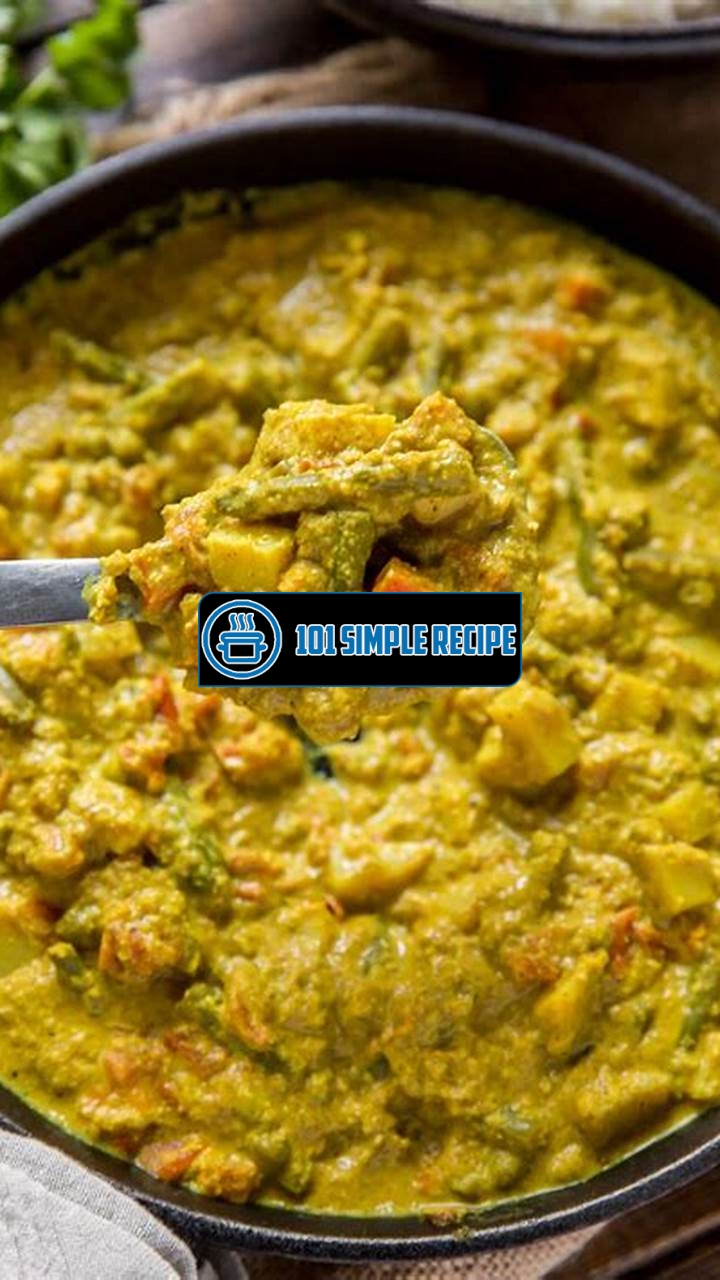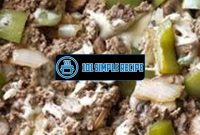Are you a fan of the rich flavors and aromatic spices of Indian cuisine? If so, you’re in for a treat with this delicious coconut vegetarian korma recipe! ✨ This mouthwatering dish combines a medley of vegetables, cooked in a creamy and fragrant coconut sauce that will leave you wanting more. Whether you’re a vegetarian or simply looking to add more plant-based options to your diet, this korma recipe is sure to satisfy your taste buds. So, grab your apron and get ready to embark on a flavorful culinary adventure!

Understanding Coconut Vegetarian Korma
Coconut vegetarian korma is a delectable Indian dish that has gained popularity around the world for its rich flavors and unique blend of spices. This creamy and aromatic curry is a favorite among vegetarians and vegans, offering a delicious option that is packed with both taste and nutrition. In this article, we will explore the origins and key ingredients of coconut vegetarian korma and delve into its numerous health benefits.
The Origins of Coconut Vegetarian Korma
Coconut vegetarian korma traces its roots back to the southern part of India, where coconut is a staple ingredient in many traditional dishes. This flavorful curry has its origins in the cuisine of the Malabar region, known for its vibrant and diverse food culture. The use of coconut in this dish showcases the abundance of this tropical fruit in the region and highlights its versatility in creating flavorful and creamy sauces.
Over time, coconut vegetarian korma has gained popularity not only in India but also in various other parts of the world. Its unique taste and creamy texture have captivated the palates of people from different culinary backgrounds, making it a sought-after dish in Indian restaurants globally.
Key Ingredients in Coconut Vegetarian Korma
The key ingredients in coconut vegetarian korma contribute to its distinctive taste and texture. While variations exist, the common elements include:
1. Coconut milk: This creamy liquid extracted from grated coconut flesh forms the base of the korma sauce, lending it a rich and velvety consistency.
2. Cashews: These nuts are often ground into a paste and added to the korma sauce to provide a creamy and slightly nutty flavor.
3. Aromatic spices: A combination of spices such as cumin, coriander, turmeric, cinnamon, and cardamom adds depth and complexity to the dish, creating a symphony of flavors.
4. Vegetables: Coconut vegetarian korma traditionally includes a variety of vegetables like carrots, peas, potatoes, and cauliflower. These vegetables not only enhance the nutritional value of the dish but also add vibrant colors to the curry.
Health Benefits of Coconut Vegetarian Korma
Coconut vegetarian korma offers several health benefits, making it a nutritious and satisfying meal choice. Let’s explore some of these benefits:
1. Rich in healthy fats: Coconut milk, a primary ingredient in korma, contains medium-chain triglycerides (MCTs) that are easily digested and metabolized by the body for a quick source of energy.
2. Packed with vitamins and minerals: The combination of vegetables and spices in coconut vegetarian korma provides essential vitamins like vitamin C, vitamin K, and minerals such as potassium and manganese.
3. Supports digestion: The presence of spices like cumin and coriander aids digestion and can help alleviate digestive discomfort.
4. Source of dietary fiber: The inclusion of vegetables in coconut vegetarian korma adds dietary fiber, which promotes a healthy digestive system and helps maintain a feeling of fullness.
5. Suitable for various dietary preferences: Being a plant-based dish, coconut vegetarian korma is an excellent option for vegetarians, vegans, and those looking for meatless meal alternatives.
Whether you’re a fan of Indian cuisine or simply looking to incorporate more flavorful and nutritious vegetarian dishes into your diet, coconut vegetarian korma is a delightful choice. Its origins, key ingredients, and health benefits make it a standout dish that satisfies both your taste buds and your nutritional needs. So go ahead, give this aromatic and creamy curry a try and indulge in its delightful flavors!
Preparing Coconut Vegetarian Korma
Discover the step-by-step process of preparing a delicious coconut vegetarian korma at home.
Gathering the Ingredients
To begin making the mouthwatering coconut vegetarian korma, gather all the essential ingredients. For this flavorful dish, you will need:
- 2 cups of coconut milk
- 1 cup of chopped vegetables (such as carrots, bell peppers, and green beans) ️
- 1 cup of diced tofu or paneer for added protein
- 1 tablespoon of vegetable oil for cooking
- 1 teaspoon of cumin seeds for a touch of deliciousness
- 1 teaspoon of ginger-garlic paste for a flavorful twist
- 1 tablespoon of your preferred curry powder for a delightful kick ️
- Salt and pepper to taste for perfect seasoning
- A handful of freshly chopped coriander leaves for garnishing
Prepping the Vegetables
Once the ingredients are ready, it’s time to prepare the vegetables for your coconut vegetarian korma. Begin by washing the vegetables thoroughly under running water. Next, peel and chop the carrots into bite-sized pieces. Similarly, dice the bell peppers and trim the green beans.
Cooking Techniques for Coconut Vegetarian Korma
Now that the vegetables are prepped, let’s explore the cooking techniques for your coconut vegetarian korma. Follow these steps to achieve a delectable outcome:
- Heat the vegetable oil in a large pan over medium heat. Add the cumin seeds and let them splutter, releasing their aromatic flavors.
- Add the ginger-garlic paste to the pan and sauté for a minute, enhancing the savory essence of the dish.
- Now, it’s time to introduce the vegetables. Add the chopped carrots, bell peppers, and green beans to the pan. Sauté them until they are tender yet retain their crunchiness.
- Once the vegetables are cooked to perfection, sprinkle the curry powder over them. Stir well to combine all the vibrant flavors. ️
- Now, pour the creamy coconut milk into the pan. Allow the korma to simmer gently, letting the flavors meld together.
- Add the diced tofu or paneer to the pan, gently stirring it into the luscious coconut curry. Let everything cook for another few minutes.
- Finally, season the coconut vegetarian korma with salt and pepper according to your taste preferences. Give it a final stir and remove from heat.
Your aromatic and delightful coconut vegetarian korma is now ready to be relished! Serve it hot, garnished with freshly chopped coriander leaves.
Note: Feel free to adjust the spice levels to suit your palate. You can also experiment by adding other vegetables of your choice to customize the dish to your liking. Enjoy this scrumptious coconut vegetarian korma with steamed rice or naan bread for a complete meal experience. Bon appétit!
Exploring Flavor Profiles in Coconut Vegetarian Korma
When it comes to a delicious coconut vegetarian korma recipe, the secret lies in the careful selection and combination of spices and seasonings. By understanding the different flavor profiles involved, you can elevate the taste of your korma to new levels. Let’s uncover the key elements that contribute to the overall flavor experience.
The Role of Turmeric and Coriander
Turmeric and coriander are two essential spices that play a significant role in coconut vegetarian korma. Turmeric adds a vibrant golden color to the dish while providing a subtle earthy flavor. Its strong antioxidant properties also offer numerous health benefits.
Coriander, on the other hand, brings a refreshing and citrusy note to the korma, enhancing its overall aroma. It pairs exceptionally well with coconut and other ingredients in the dish. Together, turmeric and coriander create a flavorful foundation that forms the basis of the korma’s taste profile.
Creating a Balanced Flavor Profile
Creating a balanced flavor profile in coconut vegetarian korma is crucial to ensure a delightful culinary experience. Apart from turmeric and coriander, the recipe may also incorporate other spices like cumin, cardamom, cinnamon, and cloves. Each spice adds its unique nuances to the overall taste.
It’s important to find the right balance among these spices, so no single flavor dominates the dish. The idea is to create a harmonious blend that allows the individual flavors to shine while complementing one another.
Additionally, the use of coconut milk or cream adds a creamy and slightly sweet element to the korma, providing a perfect counterbalance to the spices. The result is a rich, aromatic, and well-rounded flavor profile that will leave your taste buds wanting more.
How to Customize the Spice Level
One of the great things about coconut vegetarian korma is its versatility. You can easily customize the spice level according to your personal preference. Whether you like it mild or fiery hot, the choice is yours!
To make the korma milder, reduce the amount of spices such as red chili powder or cayenne pepper. This will result in a more subtle heat and allow the other flavors to come through. On the other hand, if you prefer a spicier kick, feel free to increase the amount of these spices or add a dash of hot sauce to intensify the heat. ️
Remember, it’s always a good idea to start with a small amount of spices and gradually adjust to your taste. This way, you can create a coconut vegetarian korma that perfectly suits your flavor preferences.
By understanding how spices and seasonings contribute to the flavor of coconut vegetarian korma, you can enhance the taste of your dish and create a truly memorable dining experience. Experiment with different combinations and levels of spice to find your perfect flavor balance. Happy cooking!
Variations of Coconut Vegetarian Korma
Discovering the different versions of coconut vegetarian korma is like embarking on a delightful culinary journey through various regions and cultural backgrounds. Each version brings its own unique flavors and spices to this delectable dish. From the vibrant North Indian style to the aromatic South Indian style, and even the international adaptations, coconut vegetarian korma never fails to impress.
North Indian Style Coconut Vegetarian Korma
North Indian style coconut vegetarian korma is a true gastronomic delight. Bursting with rich flavors and aromatic spices, this version of korma features a creamy coconut sauce that perfectly complements the mix of vegetables and protein. The key ingredients include coconut milk, cashews, aromatic spices like coriander, cumin, and turmeric, as well as a variety of vegetables such as potatoes, carrots, and peas. This North Indian style coconut vegetarian korma is best enjoyed with steamed basmati rice or freshly baked naan bread.
South Indian Style Coconut Vegetarian Korma
For those who love a bit of heat and intense flavors, South Indian style coconut vegetarian korma is the ideal choice. This version of korma boasts a fiery combination of spices, including red chili powder, black peppercorns, and curry leaves. The coconut flavor is still present, but it melds harmoniously with the spices to create a truly tantalizing taste experience. Traditional South Indian coconut vegetarian korma typically includes vegetables like okra, eggplant, and drumsticks, as well as a blend of roasted coconut, cashews, and aromatic spices. Served with steaming hot rice or dosa, this korma is a true delight for the taste buds.
International Adaptations of Coconut Vegetarian Korma
The popularity of coconut vegetarian korma has led to its adaptation in various international cuisines. From Thai to Caribbean, each region puts its own unique spin on this classic dish. In Thai cuisine, coconut milk forms the base of the korma sauce, which is then infused with aromatic herbs like lemongrass, galangal, and Thai basil. The resulting korma is a harmonious blend of sweet, savory, and tangy flavors. In the Caribbean, coconut vegetarian korma takes on a tropical twist with the addition of ingredients like pineapple, mango, and plantains. The fruity sweetness perfectly balances the heat from the spices, creating a delightful fusion of flavors.
In conclusion, the variations of coconut vegetarian korma offer a delightful range of flavors and culinary experiences. Whether you prefer the rich and creamy North Indian style, the spicy kick of the South Indian version, or the exotic twists of international adaptations, there is something for everyone to enjoy. So why not embark on a culinary adventure and try out these different versions of coconut vegetarian korma?
If you’re looking for more vegetarian recipes, check out our weight loss recipe and our vegan pie recipe.
Serving and Pairing Coconut Vegetarian Korma
Serving coconut vegetarian korma is a delightful experience that allows you to indulge in the rich and flavorsome taste of this popular dish. To make the most of your meal, it is essential to pair it with the right accompaniments that will complement its unique flavors and bring out its best qualities. Here are some tips on how to serve coconut vegetarian korma and the best accompaniments to enhance your dining experience.
Recommended Side Dishes
To elevate the taste of your coconut vegetarian korma, consider adding some delicious side dishes to the table. These side dishes not only add variety but also provide a perfect balance to the creamy and savory flavors of the korma. Here are a few options to consider:
- 1. Mango Chutney: Add a sweet and tangy note to your korma by serving it with a side of mango chutney. The fruity flavors of the chutney perfectly complement the creaminess of the korma, creating a burst of flavors in every bite.
- 2. Garlic Naan: The soft and fluffy texture of garlic naan pairs exceptionally well with coconut vegetarian korma. The garlic-infused bread adds a hint of savory flavor and can be used to scoop up the korma, allowing you to savor every last bit of the delicious sauce.
- 3. Cucumber Raita: If you prefer a cooling and refreshing side dish, cucumber raita is an excellent choice. The creamy yogurt mixed with cucumber, herbs, and spices provides a soothing contrast to the spiciness of the korma, creating a harmonious balance of flavors.
Choosing the Right Rice or Bread
When it comes to choosing the perfect accompaniment for coconut vegetarian korma, the choice of rice or bread plays a vital role in enhancing your dining experience. Here are some options to consider:
- 1. Basmati Rice: The fragrant and fluffy texture of basmati rice is an ideal choice to pair with coconut vegetarian korma. Its light and delicate flavor allow the korma to take center stage while providing a base to soak up the flavorful sauce.
- 2. Jeera Rice: If you prefer a slightly spiced rice option, jeera rice is an excellent choice. The aromatic cumin seeds in the rice add a flavorful twist that complements the spices in the korma.
- 3. Roti: For a healthier alternative to naan, consider serving coconut vegetarian korma with freshly made roti. The whole wheat bread provides a slightly nutty flavor that pairs well with the creamy korma.
Creating a Coconut Vegetarian Korma Menu
When planning a coconut vegetarian korma menu, it’s important to consider a variety of dishes that will complement the flavors of the korma and provide a well-rounded meal. Here are some ideas to inspire your coconut vegetarian korma menu:
- 1. Appetizer: Start your meal with a light and refreshing appetizer such as a mixed green salad with a tangy lemon dressing. This will prepare your taste buds for the flavors to come.
- 2. Main Course: Serve the coconut vegetarian korma as the star of the main course, accompanied by fragrant basmati rice or your choice of bread. Add some vegetable biryani or paneer tikka as side dishes to complete the meal.
- 3. Dessert: Finish off your coconut vegetarian korma menu with a sweet treat like mango kulfi or coconut rice pudding. These desserts provide a refreshing end to the meal and complement the flavors of the korma.
By considering these serving and pairing tips, you can elevate your dining experience with coconut vegetarian korma. Whether you’re hosting a dinner party or simply enjoying a delicious meal at home, the right accompaniments will enhance the flavors and create a memorable culinary experience.
Thank you for taking the time to read our article on the “Coconut Vegetarian Korma Recipe”! We hope you found it informative and inspiring. If you’re ready to embark on a flavor-filled culinary adventure, give this recipe a try and let your taste buds be amazed! Don’t forget to bookmark our site and visit us again later for more delicious recipes and helpful cooking tips. Happy cooking!
Frequently Asked Questions
Here are some common questions about the coconut vegetarian korma recipe:
| No. | Questions | Answers |
|---|---|---|
| 1. | Can I substitute the coconut milk with almond milk? | Yes, you can substitute coconut milk with almond milk for a different flavor profile. However, it may alter the taste and richness of the korma sauce. |
| 2. | Is this recipe suitable for vegans? | Yes, this recipe is vegan-friendly as it doesn’t contain any animal products. |
| 3. | Can I add extra vegetables to the korma? | Absolutely! Feel free to add your favorite vegetables to customize the korma to your liking. |
| 4. | How spicy is this korma recipe? | The spiciness level can be adjusted to your preference by adding more or less chili powder. |
| 5. | Can I freeze leftovers? | Yes, you can freeze the leftover korma in an airtight container for future consumption. |
| 6. | What side dishes go well with coconut vegetarian korma? | Coconut vegetarian korma pairs well with basmati rice, naan bread, or even roasted vegetables. |
Closing Thoughts
We appreciate you taking the time to explore our coconut vegetarian korma recipe. We hope it brings joy and new flavors to your table. Don’t forget to visit us again later for more exciting recipes and culinary adventures. Happy cooking!
Jump to Recipe
Coconut Vegetarian Korma Recipe

Indulge in the creamy and aromatic flavors of coconut vegetarian korma. This vegan-friendly recipe is a delightful combination of vegetables, spices, and coconut milk.
- Onion – 1 medium (finely chopped)
- Garlic – 3 cloves (minced)
- Ginger – 1 tablespoon (grated)
- Carrots – 2 medium (diced)
- Potatoes – 2 medium (diced)
- Green beans – 1 cup (chopped)
- Green peas – 1 cup
- Coconut milk – 1 can (400ml)
- Cashews – 1/4 cup
- Turmeric powder – 1/2 teaspoon
- Coriander powder – 2 teaspoons
- Cumin powder – 1 teaspoon
- Garam masala – 1 teaspoon
- Chili powder – 1/2 teaspoon (adjust to taste)
- Salt – 1 teaspoon (or to taste)
- Water – 1/2 cup
- Cilantro – for garnish
- Heat oil in a large pan over medium heat. Add onions and cook until golden brown.
- Add minced garlic and grated ginger, and cook for another minute.
- Add turmeric powder, coriander powder, cumin powder, and chili powder. Stir well to coat the onions with the spices.
- Add diced carrots, potatoes, green beans, and green peas. Cook for about 5 minutes, stirring occasionally.
- Pour in the coconut milk and water. Stir well and bring to a simmer. Cover and cook for 15-20 minutes, or until the vegetables are tender.
- In the meantime, soak cashews in warm water for 10 minutes. Drain and blend into a smooth paste.
- Once the vegetables are cooked, add the cashew paste and garam masala. Stir well and cook for another 5 minutes.
- Season with salt and adjust the consistency by adding more water if needed.
- Garnish with fresh cilantro and serve hot with basmati rice or naan bread.






